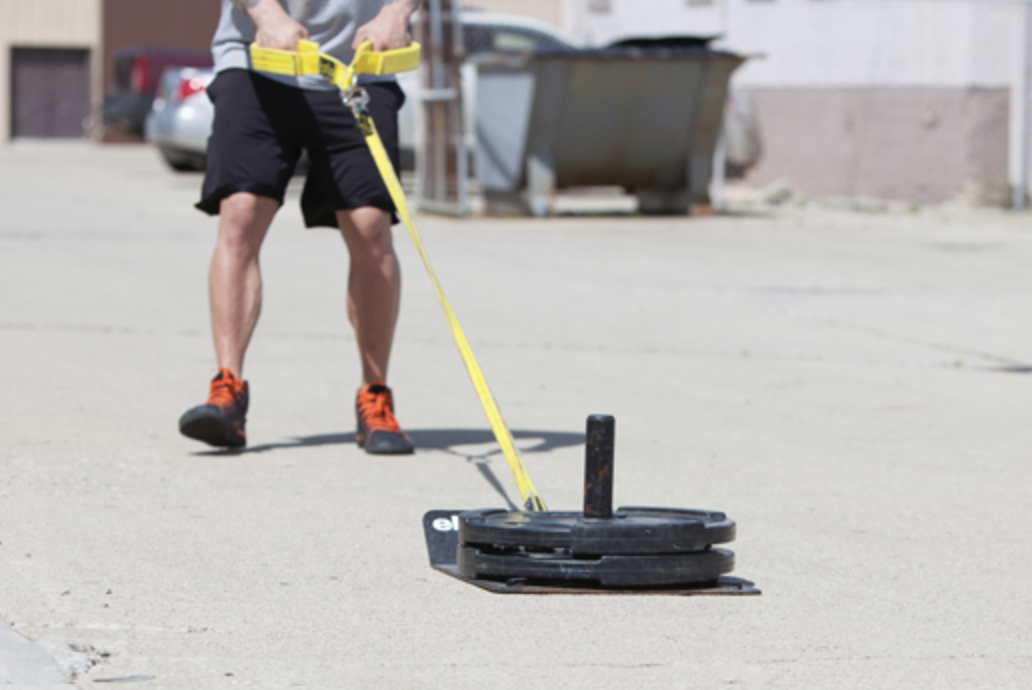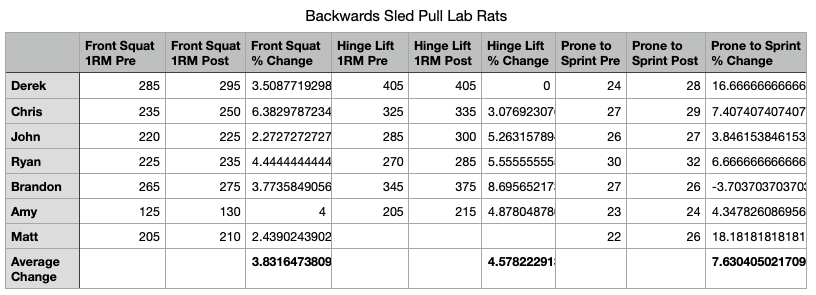By Rob Shaul
BLUF
The strength and work capacity improvement difference between Forward Sled Pull Intervals and Backward Sled Pull Intervals is negligible.
In two separate mini studies, remote lab rats saw 1 Repetition Max (1RM) strength and sprint-based improvements after following a 3-week training program which featured forward or backward sled pull repeats three-days/week. See below:
Both Mini Study results indicate sled pull repeats (forward and/or backward) are a viable exercise modality to maintain and possibly improve, both max-effort leg strength and sprint-based work capacity.
Sled pull repeats can be used to train lower body strength for austere, limited equipment situations, or as an alternative to traditional free weight training.
Background
Sled pulls and pushes are popular exercises in strongman training, football strength and conditioning, and sprint-speed training.
There is limited research available on the effects of sled pulls on sprinting speed, but none that we could find on the overall conditioning effects of high volume, interval-based sled pushes, and/or pulls. Many college weight rooms and strongman competitors swear by the strength and work capacity conditioning power of sled pushes/pulls, but to our knowledge, this has never been actually quantified.
We were especially interested in the potential for sled pushes/pulls to increase lower body strength. MTI’s evolving programming for older athletes (40+) is hesitant to prescribe the traditional heavy squatting and lunging to develop leg strength out of concern about prematurely causing knee arthritis. As well, for many older athletes, myself included, pain from knee, hip and ankle issues make loaded squats and lunges increasingly intolerable.
Without loaded squatting and lunging movements, the exercise prescription to increase lower body strength is limited, primarily to MTI’s bodyweight Leg Blaster complex, and similar bodyweight based training.
Sled drag/push intervals could offer another option to train lower body strength for not only older athletes, but all athletes.
In addition, sled drag/push intervals have a significant work capacity element – often bringing athletes to threshold, if not, panic breathing.
However, a significant programming issue with sled pulls/drags is the sled and the sliding surface greatly affect the friction and thus the difficulty of the effort. This makes it difficult for strength coaches to program load-based sled pushes/pulls for athletes.
We’re hoping an interval-based system, with a prescribed level of exertion, while not perfect, can lead to an effective way to program and progress sled pushes and drags.
We had previously conducted a Mini Study on forward sled drags.
This Mini Study repeated exactly, the programming of that previous study, but mandated the lab rats completed backwards sled drags.
Going into this mini study, we hoped to learn ….
- The effectiveness and computability of an exertion prescribed, and interval-based, backward sled push/pull programming methodology.
- The fitness effects of backward sled pulls on, lower body strength, and overall work capacity.
- A comparison between the strength and work capacity improvement potential between forward sled pulls and backward sled pulls.
Mini-Study Design
We advertised for remote lab rats with access to a sled and space to backward pull, and designed a 3-week training cycle bookended by a lower body strength and work capacity assessment:
- 1RM Front Squat
- 1RM Hinge Lift
- Max Rep 40-Foot Prone to Sprints in 3 Minutes
Between assessments, all the forward pull lab rats and backward pull lab rats completed the same 3-week training cycle. The only difference being the direction they were facing during the sled pull intervals.
The programming did not include any additional lower body strength or work capacity training beyond the sled pull intervals.
Here was the weekly schedule:
- Monday: Sled Pul Intervals
- Tuesday: Upper Body Strength, Chassis Integrity
- Wednesday: Sled Pul Intervals
- Thursday: Upper Body Strength, Chassis Integrity
- Friday: Sled Pul Intervals
- Saturday: Rest or Outdoor Recreation
- Sunday: Rest or Outdoor Recreation
Significantly for this study:
- Sled work was limited to Backward sled pulls only
- Deployed 30 second work, 60 second rest, sled pull intervals. Athletes were instructed to adjust the sled pull weight as needed to aim for a hard, slow, jog, 30-second pull.
- The interval format (30 sec work, 60 sec rest) was not changed during the duration of the cycle, but the number of intervals was progressed, from 8 rounds at the beginning to 14 rounds at the end. It total duration, the sled pull efforts progressed from 12 minutes to 21 minutes.
Results and Discussion
See the charts below.
The type of “sled” used to pull for both of these Mini Studies was not standardized – nor was the sled weight. Some lab rats were able to pull metal sleds on turf, inside. Others pulled sandbags on grass or sand, metal sleds outside on dirt or pavement, or an old wooden pallet weighted with rocks or sandbags, outside.
Dictating and prescribed sled specifics is difficult as not only does the type/weight of the sled determine its pulling resistance, but so does the sliding surface. For this reason, sled “loading” was prescribed using a “Rate of Perceived Exertion” – or RPE.
Specifically lab rats were instructed to manipulate their sled load and sliding surface and aim for a hard, slow, jog, nearly max effort, 30-second pull.
As seen above, both the forward and backward pull lat rats saw improvement in all three metrics. The most significant difference in improvement occurred for the pre and post cycle Front Squat 1RM. Although the forward pull lab rats achieved an 8.7% Front Squat 1RM improvement vs. 3.8% improvement for the backwards pull lab rats, the relatively low number of lab rats for both Mini Studies means we’re not confident stating forward sled pulls do a better job at increasing front squat strength.
Next Steps
Both Mini-Study results are encouraging and offer sled pulls (forward and/or back) prescribed in a simple exertion based, interval progression as an alternative way to train and maintain lower body strength for athletes.
Next? Two directions:
- Test sled pushes vs sled pulls.
- Experiment with different intervals … i.e. would 15/30 or 15/60 result in greater strength increases over the 30/60 intervals used in both these studies?
- Experiment with extended pull efforts … i.e 10+ minute intervals … up to 40-50 minutes.
Questions? Email coach@mtntactical.com
Comments? Please enter your comment below.
You Might Also Like MTI’s Big24 Strength Training Plan




